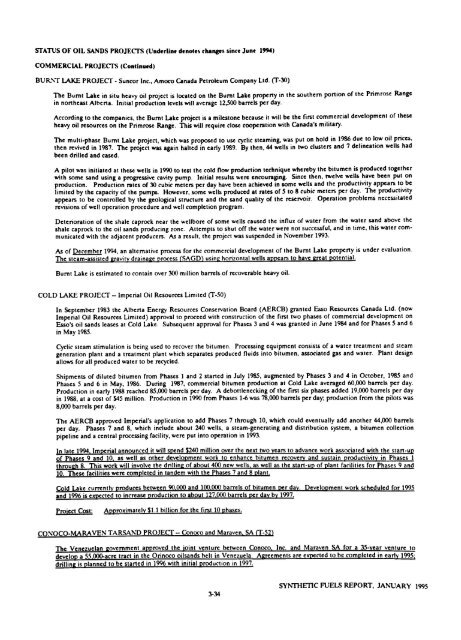Ikelic - Alliance Digital Repository
Ikelic - Alliance Digital Repository
Ikelic - Alliance Digital Repository
You also want an ePaper? Increase the reach of your titles
YUMPU automatically turns print PDFs into web optimized ePapers that Google loves.
STATUS OF OIL SANDS PROJECTS (Underline denotes changes since June 1994)<br />
COMMERCIAL PROJECTS (Continued)<br />
- BURNT LAKE PROJECT Suncor Inc., Amoco Canada Petroleum Company Ltd. (T-30)<br />
The Burnt Lake in situ heavy oil project is located on the Burnt Lake property in the southern portion of the Primrose Range<br />
in northeast Alberta. Initial production levels will average 12,500 barrels per day.<br />
According to the companies, the Burnt Lake project is a milestone because it will be the first commercial development of these<br />
heavy oil resources on the Primrose Range. This will require close cooperation with Canada's military.<br />
The multi-phase Burnt Lake project, which was proposed to use cyclic steaming, was put on hold in 1986 due to low oil prices,<br />
then revived in 1987. The project was again halted in early 1989. By then, 44 wells in two clusters and 7 delineation wells had<br />
been drilled and cased.<br />
A pilot was initiated at these wells in 1990 to test the cold flow production technique whereby the bitumen is produced together<br />
with some sand using a progressive pump. cavity Initial results were encouraging. Since then, twelve wells have been put on<br />
production. Production rates of 30 cubic meters per day have been achieved in some wells and the appears productivity to be<br />
limited by the capacity of the pumps. However, some wells produced at rates of 5 to 8 cubic meters per day. The productivity<br />
appears to be controlled by the geological structure and the sand quality of the reservoir. Operation problems necessitated<br />
revisions of well operation procedure and well completion program.<br />
Deterioration of the shale caprock near the wellbore of some wells caused the influx of water from the water sand above the<br />
shale caprock to the oil sands zone. producing Attempts to shut off the water were not successful, and in time, this water com<br />
municated with the adjacent producers. As a result, the project was suspended in November 1993.<br />
As of December 1994, an alternative process for the commercial development of the Burnt Lake property is under evaluation.<br />
The steam-assisted gravity drainage process (SAGD) using horizontal wells appears to have great potential.<br />
Burnt Lake is estimated to contain over 300 million barrels of recoverable heavy oil.<br />
- COLD LAKE PROJECT Imperial<br />
Oil Resources Limited (T-50)<br />
In September 1983 the Alberta Energy Resources Conservation Board (AERCB) granted Esso Resources Canada Ltd. (now<br />
Imperial Oil Resources approval Limited) to proceed with construction of the first two phases of commercial development on<br />
Esso's oil sands leases at Cold Lake. Subsequent approval for Phases 3 and 4 was granted in June 1984 and for Phases 5 and 6<br />
in May 1985.<br />
Cyclic steam stimulation is being used to recover the bitumen. Processing equipment consists of a water treatment and steam<br />
generation plant and a treatment plant which separates produced fluids into bitumen, associated gas and water. Plant design<br />
allows for all produced water to be recycled.<br />
Shipments of diluted bitumen from Phases 1 and 2 started in July 1985, augmented by Phases 3 and 4 in October, 1985 and<br />
Phases 5 and 6 in May, 1986. During 1987, commercial bitumen production at Cold Lake averaged 60,000 barrels per day.<br />
Production in early 1988 reached 85,000 barrels per day. A debottlenecking of the first six phases added 19,000 barrels per day<br />
in 1988, at a cost of $45 million. Production in 1990 from Phases 1-6 was 78,000 barrels per day, production from the pilots was<br />
8,000 barrels per day.<br />
The AERCB approved Imperial's application to add Phases 7 through 10, which could eventually add another 44,000 barrels<br />
per day. Phases 7 and 8, which include about 240 wells, a steam-generating and distribution system, a bitumen collection<br />
pipeline and a central processing facility, were put into operation in 1993.<br />
In late 1994. Imperial announced it will spend $240 million over the next two years to advance work associated with the start-up<br />
of Phases 9 and 10. as well as other development work to enhance bitumen recovery and sustain productivity in Phases 1<br />
through 8. This work will involve the drilling of about 400 new wells, as well as the start-up of plant facilities for Phases 9 and<br />
10. These facilities were completed in tandem with the Phases 7 and 8 plant-<br />
Cold Lake currently produces between 90.000 and 100.000 barrels of bitumen per day. Development work scheduled for 1995<br />
and 1996 is expected to increase production to about 127.000 barrels per day bv 1997.<br />
Project Cost: Approximately $1.1 billion for the first 10 phases.<br />
- CONOCO-MARAVEN TARSAND PROJECT Conoco<br />
and Maraven. SA CT-S2)<br />
The Venezuelan government approved the joint venture between Conoco. Inc. and Maraven SA for a 35-year venture to<br />
develop a 55.000-acre tract in the Orinoco oilsands belt in Venezuela. Agreements are expected to be completed in early 1995:<br />
drilling is planned to be started in 1996 with initial production in 1997.<br />
3-34<br />
SYNTHETIC FUELS REPORT, JANUARY 1995















![pace SrntfletIc fne]its report - Alliance Digital Repository](https://img.yumpu.com/10493335/1/190x245/pace-srntfletic-fneits-report-alliance-digital-repository.jpg?quality=85)
